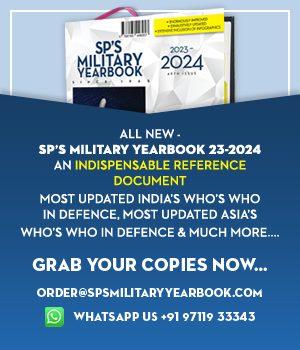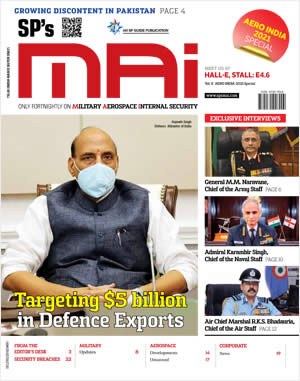INDIAN ARMED FORCES CHIEFS ON OUR RELENTLESS AND FOCUSED PUBLISHING EFFORTS
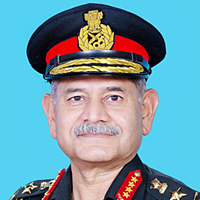
The insightful articles, inspiring narrations and analytical perspectives presented by the Editorial Team, establish an alluring connect with the reader. My compliments and best wishes to SP Guide Publications.
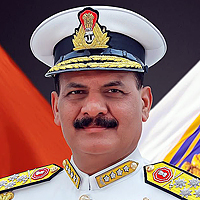
"Over the past 60 years, the growth of SP Guide Publications has mirrored the rising stature of Indian Navy. Its well-researched and informative magazines on Defence and Aerospace sector have served to shape an educated opinion of our military personnel, policy makers and the public alike. I wish SP's Publication team continued success, fair winds and following seas in all future endeavour!"

Since, its inception in 1964, SP Guide Publications has consistently demonstrated commitment to high-quality journalism in the aerospace and defence sectors, earning a well-deserved reputation as Asia's largest media house in this domain. I wish SP Guide Publications continued success in its pursuit of excellence.
- Prime Minister Modi Visits Punjab’s Adampur Air Base, Interacts with Airmen after Successful ‘Operation Sindoor’; Stern Message to Pakistan
- The layered Air Defence systems that worked superbly, the key element of Operation Sindoor
- Operation Sindoor | Day 2 DGMOs Briefing
- Operation Sindoor: India strikes back with Precision and Purpose
- Operation Sindoor: Resolute yet Restrained
- India’s Operation Sindoor Sends a Clear Message to Terror and the World – ‘ZERO TOLERANCE’
- Japan and India set forth a defence cooperation consultancy framework, talks on tank and jet engines
- Terrorist Attack in Pahalgam in Kashmir: Unfolding a long surgical war against PAK
- Lt General Pratik Sharma takes over Command of Indian Army's Northern Command
Biometrics- the future of Border-control
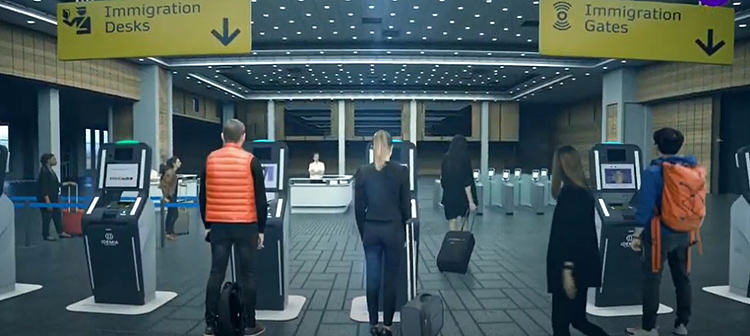
Border security has become an increasingly important issue in today's world. With the rise of globalization, the movement of people and goods across international borders has become easier than ever. By 2037, 8.2 billion air traveller's are expected worldwide according to IATA. However, with this increased mobility comes an increased risk of security threats, including terrorism, drug trafficking, and illegal immigration. To address this challenge, governments and border crossing operators need to implement effective Entry/Exit solutions by deploying near walk-through border processes to reduce waiting times, passenger identity verification, ID fraud detection, passenger eligibility check and Entry-Exit authorization.
The need for border security solutions is multifaceted. One of the primary reasons is to prevent the entry of individuals who pose a threat to national security. Terrorists and criminals often try to cross borders undetected to carry out attacks or engage in illegal activities. Border security measures can help to identify and apprehend these individuals before they can cause harm.
Another critical aspect of border security is the prevention of illegal immigration. While many people enter a country legally, there are those who do not, often using illegal means to cross borders. Illegal immigration can create a range of problems, including strain on resources, increased crime, and a negative impact on the economy. In order to keep ahead of criminals and other potential dangers and safeguard the security of a country's borders, agencies must progressively adopt new solutions. Conventional patrols and CCTV systems are no longer sufficient forms of protection.
Furthermore, border security solutions are also necessary to combat drug trafficking. Criminal organizations often use cross-border routes to smuggle drugs into countries, with devastating consequences for individuals and communities. Effective border security measures can help to intercept and seize drugs, preventing them from reaching their intended destinations.
There are several different border security solutions that countries can employ. One such solution is physical barriers, such as walls or fences, which can prevent individuals from crossing borders illegally. Additionally, border patrol agents can use technology, such as surveillance cameras, to monitor border areas and identify potential threats.
In recent years, technological advancements have played an increasingly important role in border security. Advanced biometric systems, such as facial recognition and fingerprint scanning, can help to quickly identify individuals and determine their status. This technology can help to prevent unauthorized entry and can also speed up the processing of legitimate travellers.For example a comprehensive National Entry-Exit System can process all types of travelerdata consistently throughout the country by centrally managing the specific process to be performed at land, air and sea borders and by having a real time view on all movements across the country. These National Entry-Exit Systems come with flexible designs, can be adapted to each country's border workflows, processes, regulations, and privacy policies. Also, their system interfaces easily with national and international systems, including API/PNR, biometric identification systems and Registered Traveler Programs to form a comprehensive tool to manage a country's borders.
Also, Border Control ecounter solutions, on the other hand, can help meet the challenges of streamlining guards' operations at air, sea and land borders, and reduce waiting times while offering a user-friendly interaction.
Border environments are always specific.With the capacity to adapt the process based on the passenger profile, and through the use of biometrics, governments are in a position to move from a document-centric approach to a person-centric one, improving greatly the level of confidence and fraud detection at borders.




